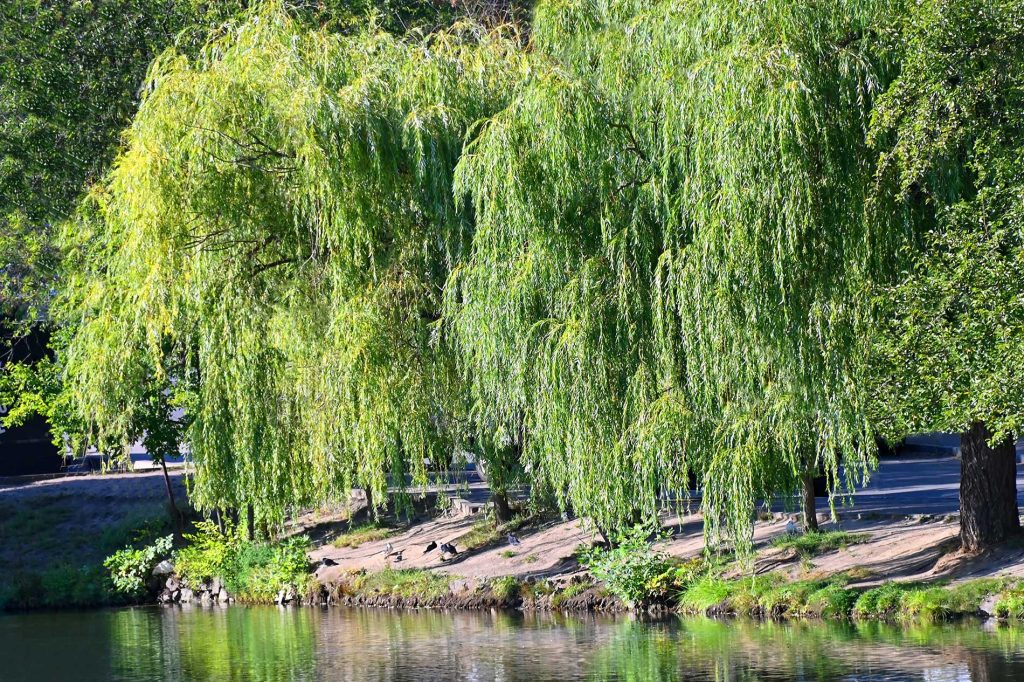The weeping willow, with its cascading branches, is a fixture of many of our local shorelines. Cultivating a weeping willow allows you to become part of the tree’s history, which can span up to half a century. They thrive when planted close to water, such as pond edges, lakeshores, or stream banks. The proximity to water provides a picturesque setting and ensures a continuous supply of moisture, which is essential for their health. While water is crucial, the soil also plays a pivotal role. Weeping willows favor well-drained soil that remains moist, but not waterlogged, to prevent root rot. The initial selection of a good spot goes a long way in avoiding future complications and nurturing a healthy foundation for the tree.
Tree Care
Consistency is key when it comes to the care of a young weeping willow. Immediately after planting, regular watering, mulching, and monitoring the soil moisture level are vital. The establishment phase can take a few years, but with proper care, the tree’s roots will grow deep and wide, ensuring resilience against drought. Pruning should be seen as a vital act of care, rather than a mere architectural reshaping of the tree’s natural form. Remove dead, crossing, or diseased branches, to prevent disease and redirect the tree’s energy to where it’s needed most.

For a weeping willow, shaping requires a skilled hand and an understanding of the tree’s growth habits. Annual pruning during the dormant season, early spring, provides fresh vitality and maintains the desired elegance. It’s during this time that the loss of foliage and sap flow are minimized, facilitating the tree’s recovery and subsequent burst of growth. Young trees may require more frequent attention to encourage a well-balanced canopy. Less is more, so avoid drastic cuts that can weaken the tree. Instead, opt for a light touch that encourages the beauty of its silhouette.
Pests and Diseases
Like any living organism, a weeping willow is not immune to pests and diseases. Watch for common issues such as cankers, fungal diseases, aphids, and caterpillars. Early detection and appropriate action are critical to maintaining the tree’s health. A regimen of horticultural oil sprays can deter many of the insect pests that frequent the willow. For diseases, a preventative copper-based fungicide in the spring can provide protection. If you notice any signs of affliction, such as wilting leaves or unusual discoloration, it is best to act promptly with targeted treatments.
While the passion of a dedicated homeowner can go a long way in maintaining the health of a weeping willow, there are those moments when the wisdom of an expert is irreplaceable. Arborists are the physicians of the tree world, and their professional eye can catch the subtleties that are often missed. Larger or older weeping willows may require the care of an arborist for routine maintenance. A consultation with such a professional offers peace of mind and a roadmap for the tree’s future care. It’s an investment, not only in your tree but in the legacy of your landscape.
Expert Care by Pine Valley Tree Services
Tending to a weeping willow is a rewarding endeavor that connects you to the rhythm of nature. The care you provide speaks volumes about your love for your home and the environment it inhabits. Enjoy the rustling leaves, the long, drooping branches, and the sheltering presence of your weeping willow. They are more than just adornments in your garden—they are living bridges between the past, present, and future of your landscape.
Call Pine Valley Tree Service & Landscaping, for professional arborist services for your weeping willow trees, including upper crown reduction and safe tree removal.
More from our blog: Professional Tree Services FAQ

